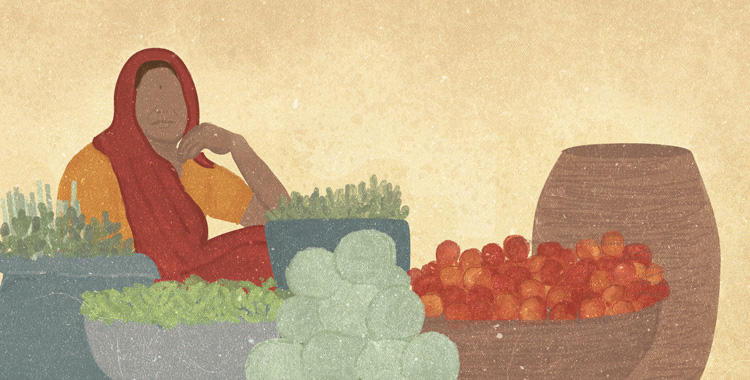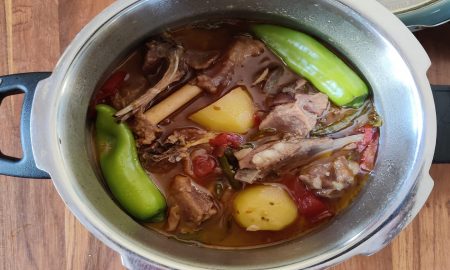Trade begins early on the streets of Jayanagar. A short walk from my accommodation not long after dawn takes me along a bustling highway to the Banashankari Temple where lazing dogs commune in the dusty compound whilst early morning worshippers pay homage to the deities. The delicate scent of sandalwood permeates the air and small devotional lamps burn at the temple entrance. Already it is warm, though a group of small, wizened men sit huddled under a ragged collection of cloths retrieving the mobility of their stiffened limbs from another cold night in the open. Continuing along the road beneath the towering pillars of the yet to function metro, a concrete monolith that scars the skyline and casts an ominous shadow over the temple grounds, I weave my path between motionless sleepers on the street and traders hurrying to market, many carrying their burden of wares balanced confidently on their heads. Walking anywhere here is fraught with potential mishaps from broken paving slabs, potholes and marauding dogs to low slung cables and wires crisscrossing the uneven pathway.
Within minutes, I arrive at the first of the vendors. Piles of hairy coconuts are arranged in haphazard fashion along the roadside verges surrounded by groups of men closing deals, loading their purchases into sacks and heaving these into the backs of small vans. The quantities purchased suggest that these essential ingredients of local cuisine are destined for the many restaurants and hotels of Jayanagar. A little further along the road and an elaborately painted lorry is being unloaded, its cargo consisting entirely of cauliflowers being neatly arranged along the road’s edge and already attracting critical customers who scrutinise them and offer judgements. Broad round rush and reed baskets of custard apples are being slid along the pathway by an elderly lady bent double over the task and wheezing with the efforts of her exertions. Work begins early for these people here in Bangalore.
Many of the stalls here feature single vegetable commodities. A five metre long pile of red skinned onions, a barrow containing only garlic and another with a tangle of bhindi stand side by side their proprietors already engaged in brisk trade. Piles of green herbs fill the air with a confusion of aromas, first one dominates and then another takes control as I walk amongst the customers who are examining wares for texture and freshness.
A covered market slows my progress as a few narrow passages, these often obstructed by people, boxes and the detritus of discarded sub-standard vegetables wind between heaps of fruit and other fresh produce. A man is dwarfed by the pile of ginger behind which he squats and a woman, giving me the characteristic Indian shake of the head and a friendly namaskar indicates a row of neatly arranged courgettes bidding me buy.
Back outside rows of barrows provide a forum for flower sellers with their carefully constructed garlands of vermillion, yellows, blues and greens. Customers mill around the brightly coloured stalls as one vendor of the vendors fends off an over eager cow, keen to make a meal of his display. All is bustle, light hearted chatter, hand waving negotiation, head shaking and trade.
Amongst what is seeming chaos to those unfamiliar with this scene, I am struck by the immense pride that vendors take in the management of their stalls. Vegetables are neatly regimented in orderly lines and pyramids. Garlands are lovingly arranged in a manner carefully calculated to display their colours to best advantage. Stall holders delicately shift and order fruit and vegetables, eager to ensure that customers are able to evaluate their best features. These are no wealthy business men and women but are rather drawn from the poorer communities of the city. Many have pushed their barrows considerable distances arriving early to gain an advantageous pitch and a position from which they can be most easily viewed. Most are spindly limbed, short in stature and stronger than men twice their size.
These are vendors with great dignity. They take so obvious a pride in their work and delight when customers or even mere observers such as myself, take an interest in their labours. There is so much here to be admired as these noble people exhibit and barter their goods. How, I wonder, might a formal education have impacted their lives? More especially, how much value do we place upon the knowledge, the skills and the craft that they present to the discerning eye? Here I see individuals with great understanding and a collective of traders whose combined knowledge is a source of almost certainly underestimated value.
I suspect that the majority of the vendors working here have had little more than what we would regard as a rudimentary education. Maybe with increased opportunities some of these individuals would be working in vastly different situations. Education can be a means of liberation, but if we restrict our interpretation of its nature, it could equally be limiting and create false values within our communities. I would like to propose that the service that these traders on the streets of Jayanagar give to the people of the local community is every bit equal to that of the software engineers and call centre managers who work in locations not too distant from here.
In the scene I have witnessed this morning, one that is replicated in towns, villages and cities across India and much of the wider world, I see people working with pride and dignity who use their learning for the support of their families and in order to provide an essential service to their community. These may not be educated people in the eyes of those who manage national education policies and systems, but surely we should celebrate the understanding that they demonstrate which is beyond that held by those of us who bear the labels associated with a formal education. I hope to return here many times to show my respect for these hard working dignified people who exhibit their learning through an expert plying of their trade.
Long Live the cows of Jayanagar!
Over the years of visiting India, I have become rather fond of cows. These amiable, docile creatures are probably the least offensive of road users in the country, and are most certainly deserving of the respect that they generally receive from the Bangalorians. I often stop to pass the time with one or two of these bovine wanderers when out on my early morning promenade of the local streets. Though I confess the conversation tends to be limited, as I suspect that the average Bangalore cow has a limited appreciation of English and my Cow-Kannada is all but non-existent.
I suppose that in common with most English visitors to India, when I first visited the country I was somewhat taken aback to find so many cows occupying the streets of a major metropolis. But now I find that they are one of the more soothing features of the urban landscape, quieter than the average street occupant, and a welcome sight as they amble along the roads and lanes of Bangalore. Furthermore, I have come to realise that they perform a number of essential functions without which the city would be a poorer place.
The most obvious contribution made by these citizens of the streets is that of providing milk. Indeed this morning whilst meandering through the back lanes beyond Madhavan Park I paused for a while to watch a lady milking a most tranquil black and white animal as it chewed methodically through a pail of vegetation that she had provided. The grazing in the city is unusual to say the least, and I wonder about the quality of the milk obtained.
A second function and one that is most obvious to anyone who explores these streets is the hopeless attempt that the cows make to manage the rubbish that lies on almost every street corner. At this time of year, the Dussehra festival must be greatly welcomed by these would be refuse managers, as the litter over which they pick is greatly enhanced by fruit and coconuts used and then discarded in many ceremonies. I have noted near the rooms where I stay, a particular pile of rubbish that is greatly favoured by several black cows who have been regular visitors, exploring the menu and then eating their fill. The local crows are clearly disturbed by this behaviour and have certainly been pushed some way down the pecking order as they hover around awaiting their turn to dine. Even the black kites appear respectful of the cows, often circling above but seldom disturbing their pasture.
A major contribution that these beautiful creatures make to the city is one that I suspect is overlooked by many, but may be a source of frustration to a few. I have noted that they are the most efficient traffic calmers. A few days ago, I witnessed two guerrilla tactics adopted by cows in order to assert their authorities on the streets. In the first instance, a very large and confident black cow simply lay down in the street forcing every vehicle to slow down and weave a delicate passage around the reclining beast. Several drivers hooted, but the cow was unimpressed having found a wholly suitable space for an afternoon rest and being determined to assert her rights. Incidentally, although this cow herself had two fine horns, she never saw the necessity to honk back! Later that same day I noticed two cows, one black and white, the other brown working most efficiently in tandem. Strolling methodically and at a leisurely pace along the centre of a main road, they had developed the technique of rhythmically rocking from side to side and avoiding travelling in anything that might resemble a straight line. The effect was dramatic. Much of the traffic was hesitant to pass and the bustle of the city street was albeit temporarily, calmed.
So it is you see that I have come to admire and appreciate the many virtues of these wonderful animals. They are truly the matriarchs of the road and play so many essential roles in maintaining the equilibrium of Bangalore. Such are their qualities that I think on my return home I may send a recommendation to the council in Northampton, suggesting that a herd or two of cattle might be an excellent addition to the town centre!
Long live – the cows of Bangalore!
****
Illustration: Shreyaa Krritika Das
V
Vendors of Dignity & Cows of Jayanagar





